Summary: in this tutorial, you will learn about MySQL aggregate functions including AVG, COUNT, SUM, MAX and MIN.
Introduction to MySQL aggregate functions
An aggregate function performs a calculation on multiple values and returns a single value.
For example, you can use the AVG() aggregate function that takes multiple numbers and returns the average value of the numbers.
The following illustrates the syntax of an aggregate function:
function_name(DISTINCT | ALL expression)Code language: SQL (Structured Query Language) (sql)In this syntax:
- First, specify the name of the aggregate function e.g.,
AVG(). See the list of aggregate functions in the following section. - Second, use
DISTINCTif you want to calculate based on distinct values orALLin case you want to calculate all values including duplicates. The default isALL. - Third, specify an expression that can be a column or an expression that involves column and arithmetic operators.
The aggregate functions are often used with the GROUP BY clause to calculate an aggregate value for each group e.g., the average value by the group or the sum of values in each group.
The following picture illustrates the SUM() aggregate function is used in conjunction with a GROUP BY clause:
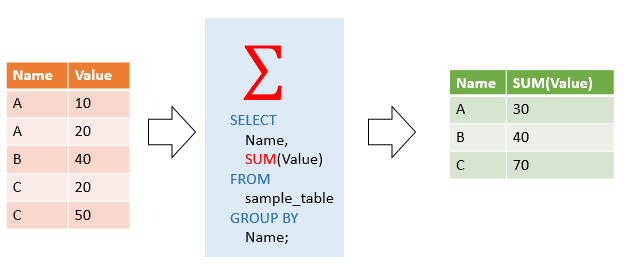
MySQL supports the following aggregate functions:
| Aggregate function | Description |
|---|---|
| AVG() | Return the summation of all non-NULL values in a set. |
| BIT_AND() | Perform a bitwise AND of values in a column of a table. |
| BIT_OR() | Perform a bitwise OR of values in a column of a table. |
| BIT_XOR() | Perform a bitwise XOR of values in a column of a table. |
| COUNT() | Return the number of rows in a group, including rows with NULL values. |
| COUNT(DISTINCT) | Count the number of unique values of a column in a table. |
| COUNT(IF) | Count the number of values that meet a specified condition. |
| GROUP_CONCAT() | Return a concatenated string. |
| JSON_ARRAYAGG() | Return result set as a single JSON array. |
| JSON_OBJECTAGG() | Return result set as a single JSON object. |
| MAX() | Return the highest value (maximum) in a set of non-NULL values. |
| MIN() | Return the lowest value (minimum) in a set of non-NULL values. |
| STDEV() | Return the summation of all non-NULL values in a set. |
| STDDEV_POP() | Return the population standard deviation. |
| STDDEV_SAMP() | Return the sample standard deviation. |
| SUM() | Return the summation of all non-NULL values a set. |
| SUM(IF) | Perform conditional summation using the SUM and IF functions. |
| VAR_POP() | Return the summation of all non-NULL values in a set. |
| VAR_SAMP() | Return the sample variance of values in a column of a table. |
| VARIANCE() | Return the population standard variance of all non-NULL values in a set. |
MySQL aggregate function examples
We will use the products and orderdetails tables from the sample database for demonstration:
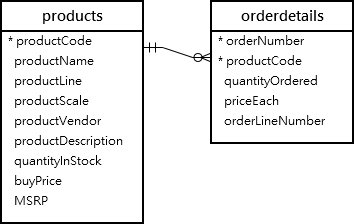
The AVG() function examples
The AVG() function calculates the average value of a set of values. It ignores NULL in the calculation.
AVG(expression)Code language: SQL (Structured Query Language) (sql)For example, you can use the AVG function to calculate the average buy price of all products in the products table by using the following query:
SELECT
AVG(buyPrice) average_buy_price
FROM
products;Code language: SQL (Structured Query Language) (sql)
The following example uses the AVG() function to calculate the average buy price for each product line:
SELECT
productLine,
AVG(buyPrice)
FROM
products
GROUP BY productLine
ORDER BY productLine;
Code language: SQL (Structured Query Language) (sql)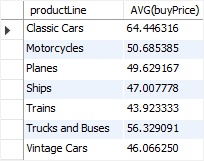
The COUNT() function examples
The COUNT() function returns the number of the values in a set.
For example, you can use the COUNT() function to get the number of products in the products table as shown in the following query:
SELECT
COUNT(*) AS total
FROM
products;Code language: PHP (php)
The following statement uses the COUNT() function with the GROUP BY clause to get the number of products for each product line:
SELECT
productLine,
COUNT(*)
FROM
products
GROUP BY productLine
ORDER BY productLine;
Code language: SQL (Structured Query Language) (sql)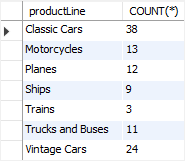
The SUM() function examples
The SUM() function returns the sum of values in a set. The SUM() function ignores NULL. If no matching row is found, the SUM() function returns NULL.
To get the total order value of each product, you can use the SUM() function in conjunction with the GROUP BY clause as follows:
SELECT
productCode,
SUM(priceEach * quantityOrdered) total
FROM
orderDetails
GROUP BY productCode
ORDER BY total DESC;Code language: SQL (Structured Query Language) (sql)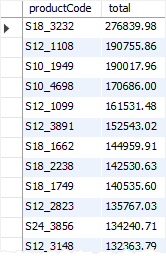
To see the result in more detail, you can join the orderdetails table to the products table as shown in the following query:
SELECT
productCode,
productName,
SUM(priceEach * quantityOrdered) total
FROM
orderDetails
INNER JOIN
products USING (productCode)
GROUP BY productCode
ORDER BY total;Code language: SQL (Structured Query Language) (sql)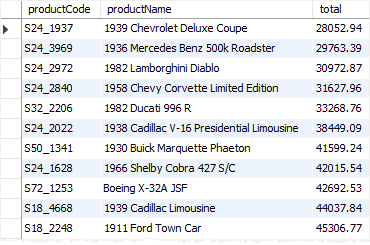
The MAX() function examples
The MAX() function returns the maximum value in a set.
MAX(expression)Code language: SQL (Structured Query Language) (sql)For example, you can use the MAX() function to get the highest buy price from the products table as shown in the following query:
SELECT
MAX(buyPrice) highest_price
FROM
products;Code language: SQL (Structured Query Language) (sql)
The following statement uses the MAX() function with the GROUP BY clause to get the highest price per product line:
SELECT
productLine, MAX(buyPrice)
FROM
products
GROUP BY productLine
ORDER BY MAX(buyPrice) DESC;Code language: SQL (Structured Query Language) (sql)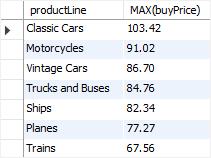
The MIN() function examples
The MIN() function returns the minimum value in a set of values.
MIN(expression)Code language: SQL (Structured Query Language) (sql)For example, the following query uses the MIN() function to find the lowest price from the products table:
SELECT
MIN(buyPrice) lowest_price
FROM
products;Code language: SQL (Structured Query Language) (sql)
The following example uses the MIN() function with the GROUP BY clause to get the lowest price per product line:
SELECT
productLine,
MIN(buyPrice)
FROM
products
GROUP BY productLine
ORDER BY MIN(buyPrice);Code language: SQL (Structured Query Language) (sql)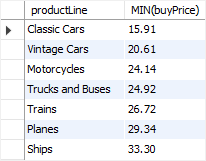
The GROUP_CONCAT() function example
The GROUP_CONCAT() concatenates a set of strings and returns the concatenated string. See the following employees and customers tables:
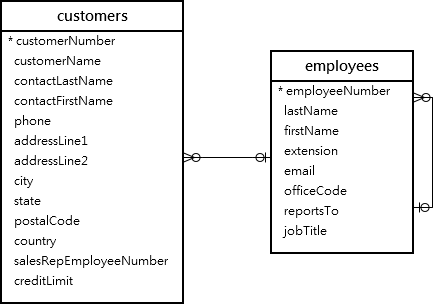
The following statement uses the GROUP_CONCAT() function to return the sales staff and list of customers that each sales staff is in charge of:
SELECT
firstName,
lastName,
GROUP_CONCAT(
DISTINCT customername
ORDER BY customerName) customers
FROM
employees
INNER JOIN customers
ON customers.salesRepEmployeeNumber = employeeNumber
GROUP BY employeeNumber
ORDER BY firstName , lastname;Code language: SQL (Structured Query Language) (sql)
In this tutorial, you have learned how to use the most commonly used MySQL aggregate functions.